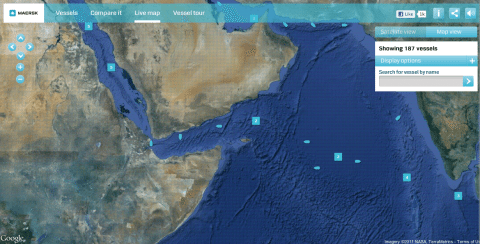North Korea Launches Probe into Warship Launch Fail
North Korea has begun a full-scale investigation into the accident that occurred during the launch of a warship this week, state media KCNA reported on Friday.


We can give full credit to the maritime industry and security firms since the navy now estimates that 90% of pirate attacks are deterred by private security on board ships. Many other attacks never occurred because of the speed of the ship, weather, the implementation of best management practices, or unknown factors that encouraged pirates to look elsewhere for victims. The effect of international naval patrols, identifying pirate activity before they leave land, general attrition by more aggressive navies, legal acts, and protests by local communities have all led to the erosion of piracy off Somalia.
Erik Rabjerg Nielsen, director and head of operations and deployment for Maersk Line, announced in May 2011 that increased surcharges to cover increased security costs. Maersk Line expects its piracy-related costs to double in 2011 to $200 million to cover insurance premiums, hardship allowances and the rerouting of vessels away from high-risk zones in the region, according to Morten Engelstoft, its chief operating officer. “In 2010, one hijacking attempt was registered every six days, and in 2011 there’s been a large increase in the activity,” Nieslon said. “The problem has never been larger than right now.”
According to estimates by the London-based International Chamber of Shipping, piracy cost shipping companies as much as $12 billion in 2010.
Maersk has increased its security surcharge by 20-50% to $200-$500 per 40-foot container on shipments through the Indian Ocean, Arabian Sea and Gulf of Aden. Shipping rates from China to Europe are about $1,300 per 40-foot container, eastbound rates from Europe to Asia are $700. The new maximum rate of $500 would be in addition to those costs.
Somalia Report has found the opposite to be true. These facts and estimates have been based on extrapolating a trajectory of steady increases since 2005 in the region. In 2011 the number of attacks may have increased but success has plummeted to around 12%. Less ships are in custody, less hostages are being abused and the expected post monsoonal surge in pirating has simple not happened.
Better management practices, more security on board and less pirates at sea could make 2011 the year of the downturn. So why aren’t shipping rates and insurance going down?
Maersk is the world’s largest (more than 1000 ships) and oldest (over 100 years old) shipping company with an impeccable reputation in the industry. Their singular event with the Maersk Alabama brought them face to face with piracy, international headlines and the messy business of having SEAL Team 6 come to your rescue. It’s understandable that their calculation of the damages by piracy extend beyond just the hard costs of financial loss.
The current hysteria over pirates could be compared to the hysteria and costs spent post 9/11 to endlessly drive up security expenses and then simply pass them on to consumers who have no say in the matter and less knowledge of the effectiveness. The UK took the refreshing step of allowing UK flagged ships to carry armed guards. Despite the controversy around land based private security contractors, there has been little evidence to show that voluntary hiring of armed guards is comparable in potential liability.

Maersk operates in an open and productive way, you can even watch their ships sail around the world, with speed, destination and cargo on theirinteractive map. Because of this careful approach to risk management, the odds are high you won’t see any Maersk ships being hijacked by pirates,attacked yes, but not taken. So clearly their risk management approach works, even if it adds steep costs to their services.
Somalia Report met with Maersk last year, sailed on commercial cargo ships in the pirate regions, and got some insight into how the shipping business works and how they view piracy. The bottom line is…the bottom line. Piracy is just one of many risks that must be managed and perhaps more importantly, any increased costs passed on to customers to ensure profit.
Piracy affects much less than 1% of 23,000 ships that pass through the Gulf of Aden and even less in the Indian Ocean. Despite the publicity, piracy is a non-event compared to the more traditional hazards a ship owner must calculate. Being a mariner is considered by the US Bureau of Labor Statistics as one of the world’s most dangerous jobs.
A fleet owner must pass on the extra fuel measured in tons per day. Frontline Ltd., the world’s largest supertanker fleet, estimates their diversion costs for one of their ships in the region at about $100,000. There is also the fuel used to sail faster to avoid pirates boarding in the danger zones. Shippers must pay higher insurance premiums, harden ships (just the barbed wire for one ship can cost $10,000), hire security crews, and provide training and equipment. Maersk ships have high freeboard and steam at well above the danger zone of 12 – 10 knots. There are some rule of thumb costs but each voyage has unique expenses related to piracy. All of these costs must be folded into what they charge for their transport and the cargo owners will add the cost of the increased shipping into their products to the consumer.
Shipping owners and insurance companies do not work in a vacuum. Higher costs affect business. They make informed decisions after reviewing presentations from security and intelligence companies. So in the face of reduced risk of ships being pirated, why aren’t insurance and shipping rates going down?
Lloyds, a major insurer, has also increased the cost of insurance, expanding its danger zone to the size of Europe. That move dramatically increases insurance costs up to 300%. Although India insists that its aggressive actions have pushed pirates away, its shipping industry must pay the higher premiums. Ransoms are higher, violence is up dramatically and hostage negotiation periods are longer so the insurance industry should get a fair return on the risk. But the 100% success rate of armed guards on ships has essentially created the magic antidote for piracy that would preclude higher premiums if a shipper were to follow simple guidelines to meet a predetermined standard.
Previously the three day transit through the Gulf of Aden was the exclusion zone, now insurance must be paid on a ten day voyage in an area around one million square miles. The Indian National Shipowners’ Association says that has increased insurance costs from a low of $500 to as much as $150,000 per voyage. Increasing the exclusion zone has added approximately 6,000 more sailings must pay the increased premiums.
Insurance providers of War Risk (usually calculated at .01% of the ship’s value) and KRE (kidnap, ransom and extortion based on the rising costs of ransoms paid out, now around $4.5M per ship) insurance premiums have increased 20% since January of this year. “Exclusion zones” where normal global insurance rates do not apply due to have been increased from 150 to 200 miles off the coast of Somalia. Regional exclusion zones now include the coast of Somalia, the Arabian Sea, the Gulf of Aden, Gulf of Oman and The Indian Ocean. Overall companies expect piracy-related costs to double in 2011 to reflect what they expect are increased risks. The increase is necessary to pass on some of the company’s rising costs to customers according to Erik Rabjerg Nielsen of Maersk.
The problem Somalia Report is seeing is that there is ample evidence of increased costs voluntarily spent by the industry to manage risk but less and less evidence of increased risk to justify those costs. Customers, nations and the media should be encouraged to ask why.
Somalia Report welcomes your opinions and insights in either formal or informal manner. Please send any correspondence to: [email protected]

Sign up for gCaptain’s newsletter and never miss an update

Subscribe to gCaptain Daily and stay informed with the latest global maritime and offshore news


Stay informed with the latest maritime and offshore news, delivered daily straight to your inbox
Essential news coupled with the finest maritime content sourced from across the globe.
Sign Up